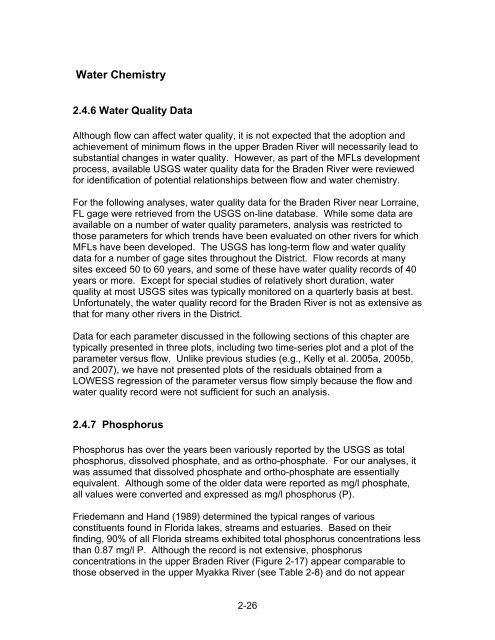Chapter 1 Minimum Flows and Levels - Southwest Florida Water ...
Chapter 1 Minimum Flows and Levels - Southwest Florida Water ...
Chapter 1 Minimum Flows and Levels - Southwest Florida Water ...
You also want an ePaper? Increase the reach of your titles
YUMPU automatically turns print PDFs into web optimized ePapers that Google loves.
<strong>Water</strong> Chemistry<br />
2.4.6 <strong>Water</strong> Quality Data<br />
Although flow can affect water quality, it is not expected that the adoption <strong>and</strong><br />
achievement of minimum flows in the upper Braden River will necessarily lead to<br />
substantial changes in water quality. However, as part of the MFLs development<br />
process, available USGS water quality data for the Braden River were reviewed<br />
for identification of potential relationships between flow <strong>and</strong> water chemistry.<br />
For the following analyses, water quality data for the Braden River near Lorraine,<br />
FL gage were retrieved from the USGS on-line database. While some data are<br />
available on a number of water quality parameters, analysis was restricted to<br />
those parameters for which trends have been evaluated on other rivers for which<br />
MFLs have been developed. The USGS has long-term flow <strong>and</strong> water quality<br />
data for a number of gage sites throughout the District. Flow records at many<br />
sites exceed 50 to 60 years, <strong>and</strong> some of these have water quality records of 40<br />
years or more. Except for special studies of relatively short duration, water<br />
quality at most USGS sites was typically monitored on a quarterly basis at best.<br />
Unfortunately, the water quality record for the Braden River is not as extensive as<br />
that for many other rivers in the District.<br />
Data for each parameter discussed in the following sections of this chapter are<br />
typically presented in three plots, including two time-series plot <strong>and</strong> a plot of the<br />
parameter versus flow. Unlike previous studies (e.g., Kelly et al. 2005a, 2005b,<br />
<strong>and</strong> 2007), we have not presented plots of the residuals obtained from a<br />
LOWESS regression of the parameter versus flow simply because the flow <strong>and</strong><br />
water quality record were not sufficient for such an analysis.<br />
2.4.7 Phosphorus<br />
Phosphorus has over the years been variously reported by the USGS as total<br />
phosphorus, dissolved phosphate, <strong>and</strong> as ortho-phosphate. For our analyses, it<br />
was assumed that dissolved phosphate <strong>and</strong> ortho-phosphate are essentially<br />
equivalent. Although some of the older data were reported as mg/l phosphate,<br />
all values were converted <strong>and</strong> expressed as mg/l phosphorus (P).<br />
Friedemann <strong>and</strong> H<strong>and</strong> (1989) determined the typical ranges of various<br />
constituents found in <strong>Florida</strong> lakes, streams <strong>and</strong> estuaries. Based on their<br />
finding, 90% of all <strong>Florida</strong> streams exhibited total phosphorus concentrations less<br />
than 0.87 mg/l P. Although the record is not extensive, phosphorus<br />
concentrations in the upper Braden River (Figure 2-17) appear comparable to<br />
those observed in the upper Myakka River (see Table 2-8) <strong>and</strong> do not appear<br />
2-26
















